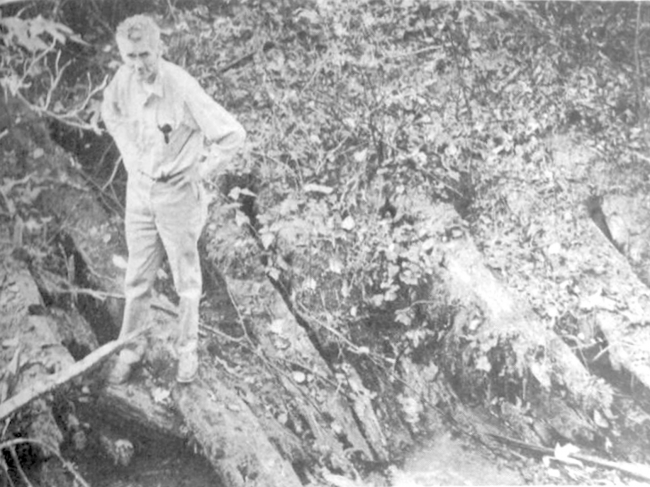A look back: Clarence Gresset loved White Center
Clarence Gresset on his property in 1974
Thu, 06/04/2015
By Tim Robinson
In the 1950-60's, along Ambaum Boulevard near SW 118th St., for many years, stood a sign; “Fill Dirt Wanted”. The sign was posted by Clarence Gresset, long time resident and local historian who owned the property. The sign emphasized "clean-fill" so contributors would not discard their yards scraps.
We don't know if anyone actually ever dumped a load of good dirt for Clarence.
It seemed an unlikely request that anyone would take the time to rid themselves of perfectly good dirt. What the sign did say was that Clarence Gresset was a man of opportunity and dreams of building a better community.
The big sign was between White Center and the Green Center trailer park just before the Salmon Creek curve. Gresset was closer to Green Center but wrote about the history of White Center for good reason. Not much was happening in that old trailer park but White Center was a hub of activity sitting just across the Seattle city limit at SW Roxbury street.
Activity like rows of taverns, boxing matches for a big crowd in the dense smoke of sweating bodies, laying leather to each other in the middle of the ring in the Southgate roller rink, not to mention illegal bootleg whiskey coming in from Seola Beach or Salmon Creek .
The hard scrabble ground of a new town like White Center did not cater to the weak. For many years White Center was a “tough town.” Longshoremen, steel workers and rowdies lined the bar stools. If a fight did not break out once a night it was probably Sunday when the bars were closed.
Clarence learned about hardship, tenacity and perseverance of life in White Center in those days.
He learned more when he dropped out of Highline High School in 1935 to ride the rails. Home life did not agree with Clarence at age 16.
He learned life wasn’t easier on the outside either. After a year on the freight cars from Seattle to Salt Lake and San Francisco to St. Louis, Clarence came back home. It was 1936. He needed to make up his junior year and his senior year at the same time to graduate.
Family members say he was stubborn, taciturn, temperamental and very strict. He was hard on himself, leaving school for life on the rails in the middle of the Great Depression. If not for Birdie Davis, a teacher at Highline High, Clarence might not have made it. Birdie offered him a chance. Two years of education crammed into 12 months allowed him to graduate on time in 1937. She was a saint.
Clarence, was born in Seattle to Olaf & Sophie Gresset. Olaf had emigrated to Ballard in 1911 meeting up with a cousin, Ole Iver Thorsen a master boat builder. Olaf met Sophie in Seattle, marrying her in 1918.. By 1919 Olaf and Sophie left Ballard, making their way south to the Dumar district, down Delridge Way SW where Clarence was born.
The family moved after a year, closer to Salmon Creek at the "Farm" just down 116th at 19th SW. Later they moved again to the corner of Ambaum at 116th SW at what the family called “the old storefront.”
When the U.S. entered that war in December 1941, Clarence enlisted three weeks later. Beginning in the motor pool, he worked his way up to paratrooper, landing behind enemy lines on D-Day in 1944. He was later captured during operation Market Garden, the daylight drop into Holland. After 9 months in a POW camp he weighed less than 100 lbs. He was released and returned home.
Settling in White Center, near the Field House, Clarence began a family with his new wife Maxine (now 94). Daughter Pat was born there.
By 1950 Clarence had built a beautiful home on 7 acres above Salmon Creek at 118th SW. Four more children followed, the last being Ken who currently works for King County. Clarence learned carpentry from his father, Olaf (Ole) and an education provided by the GI bill after WW2.
Always community minded, Clarence ran for a school board seat. He was known for his involvement in getting a community college started, for working on the construction of the King County Library in White Center and his love of history.That love translated into pictures and notes about how the White Center area developed (see historylink.org) . The Gresset family donated an unpublished manuscript to the King County Library.
Along Ambaum Boulevard just south of the Gresset homestead, in the dip called the Salmon Creek curve, there is no sign, no indication to tell us about the big, bright Salmon that spawned there. Or about the remnants of the old skid road at the base of the creek A skid road used by the loggers and bootleggers alike to move their products. A story Clarence could easily tell. He could tell you about how White Center rose from the dirt, how the shops and taverns filled the streets over the years. The stories began in that dirt.
Clarence might have had a quiet demeanor, a strict sense of purpose and grit to see things through, including his love of the area. His unfinished manuscript is unfinished because he passed away too soon in 1976. Now it is left to others to tell the stories of White Center's past. Clarence would love that.



